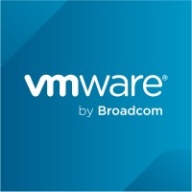

Find out what your peers are saying about Camunda, BMC, Temporal Technologies and others in Process Automation.
Most of the time, we have to raise the case with the vendors such as HPE or other providers, but in case of VMware Cloud Director or any other VMware product, 70-80% of problems we can easily troubleshoot by leveraging public documentation and the available KB articles.
VMware Cloud Director is quite scalable; I would rate it nine out of ten.
I would rate scalability for VMware Cloud Director as 8, especially from the on-premises environment.
There are occasional problems when trying to increase the parameters of a virtual machine.
Cross-cloud migration refers to if a customer has something on Azure, wanting to bring it up on VMware or maybe from VMware to AWS, vice versa.
The console methods make management difficult until VMware tools are installed.
The pricing for VMware Cloud Director is more or less reasonable, especially when compared to Cisco, which is significantly more expensive.
From a pricing perspective, I would rate VMware Cloud Director as 7 because being the available feature set, Broadcom always offered more price compared to another product.
The most valuable feature of VMware Cloud Director is segregating the underlying infrastructure for the end user.
A notable feature is the Independent Disk, which allows detaching a virtual drive from one virtual machine and attaching it to another, enabling more flexibility in operations.
| Product | Market Share (%) |
|---|---|
| OpenText Operations Orchestration | 0.7% |
| Camunda | 23.9% |
| Temporal | 7.6% |
| Other | 67.80000000000001% |
| Product | Market Share (%) |
|---|---|
| VMware Cloud Director | 5.4% |
| VMware Aria Automation | 9.5% |
| Morpheus | 7.6% |
| Other | 77.5% |


| Company Size | Count |
|---|---|
| Small Business | 4 |
| Midsize Enterprise | 2 |
| Large Enterprise | 20 |
| Company Size | Count |
|---|---|
| Small Business | 24 |
| Midsize Enterprise | 11 |
| Large Enterprise | 36 |
OpenText Operations Orchestration (OO) automates, integrates, and orchestrates any IT process, on cloud or off. Automate using low-code/no-code workflow authoring options. Integrate with an API rich, extensible platform. Centrally orchestrate powerful, scalable workflows.
With OO you can automate and orchestrate infrastructure automation and IT processes from service fulfillment to incident remediation, cloud service delivery, and disaster recovery.
Operations Orchestration offers the tools needed to provide enterprise wide orchestration capabilities:
Operations Orchestration offers the following components:
VMware Cloud Director, also known as vCloud Director, is a cloud management tool that offers secure, flexible, and efficient cloud resources to thousands of enterprises and IT teams across the world. The solution serves as one of the leading cloud service-delivery platforms for businesses that want to manage and operate their services effectively. By deploying this solution, companies can benefit from virtualized networking, computing, security, and storage. These benefits can be received in a timely manner, as the infrastructure of the product is operationally ready within minutes and clients do not need to install and configure physical infrastructure.
One of the biggest advantages of vCloud Director is that it allows users to build cloud-ready applications. In several ways, it facilitates the process for developers, including:
vCloud Director Features
This VMware product has various features through which users can virtualize their data and benefit from quality management solutions. Among the popular capabilities of vCloud Director are:
vCloud Director Benefits
VMware vCloud Director offers various benefits to its users. Some of these include:
Reviews from Real Users
Ajit Y., a cloud architect at a computer software company, likes VMware vCloud Director because it is a stable, truly multitenant software and the go-to tool for infrastructure as a service.
Kashif F., a divisional engineer at National Telecom Corporatio, rates vCloud Director highly because the product can be used for infrastructure provisioning without using a platform service.
We monitor all Process Automation reviews to prevent fraudulent reviews and keep review quality high. We do not post reviews by company employees or direct competitors. We validate each review for authenticity via cross-reference with LinkedIn, and personal follow-up with the reviewer when necessary.